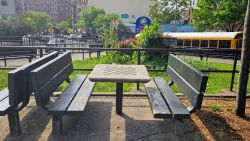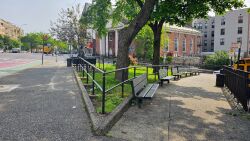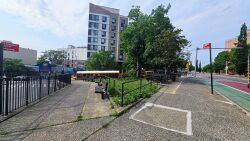Featherbed Triangle
Featherbed Triangle
What was here before?
This landscaped triangle is bounded to the west by Martin Luther King Jr. Boulevard, also known as University Avenue. This street and neighborhood of University Heights to the north reference New York University (‘NYU’), which was once based in this area. Founded in 1831 in Greenwich Village, NYU later moved to the Bronx in 1894.
Henry Mitchell MacCracken (1840-1918), a Presbyterian minister and professor of philosophy, became the chancellor of the university in 1891 and envisioned the new campus on a picturesque hill of the old Mali estate at one of the highest natural elevations in New York City. The resulting 50-acre campus, located at 180th Street between Sedgwick and University Avenues, was laid out by the notable architectural firm McKim, Mead and White, and still includes architectural relics of that age, namely Stanford White’s domed Gould Library. In 1973, to offset financial difficulties, NYU sold the land to the City University of New York (‘CUNY’). Today, Bronx Community College, which was founded in 1957 and joined CUNY in 1961, is located within the historic campus.
How did this site become a park?
The City acquired this parcel of land by condemnation in 1893, and it was transferred to NYC Parks in 1897. The park was named Featherbed Triangle on June 17, 1987. The triangle is framed with benches that surround mature trees and a lawn.
What is this park named for?
There are four differing origin stories surrounding the name of adjacent Featherbed Lane, the namesake of this triangle. One says that during the Revolutionary War, locals covered the street with featherbeds so soldiers fighting the British could move quietly through the area. Another declares the road to have been so rough that those who traveled on it padded their carriage seats with featherbeds to keep it from being too uncomfortable. A third story, partly contradicting the first two, suggests that the road’s muddy composition provided a similar effect to that of a featherbed and made for a very smooth ride. The last theory suggests that the name dates from the 1840s, when the area was home (and office) to many prostitutes.
Check out your park's Vital Signs
Clean & Safe
Green & Resilient
Empowered & Engaged Users
Share your feedback or learn more about how this park is part of a
Vital Park System





